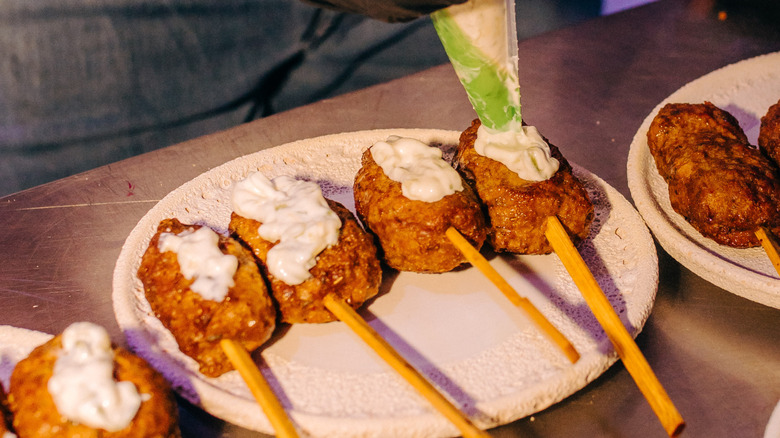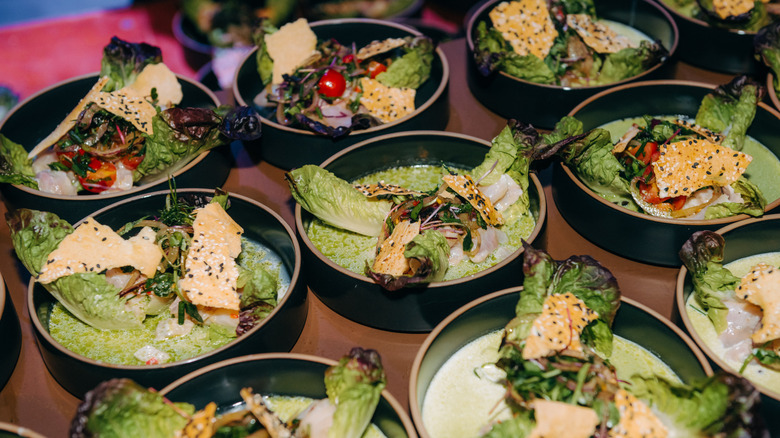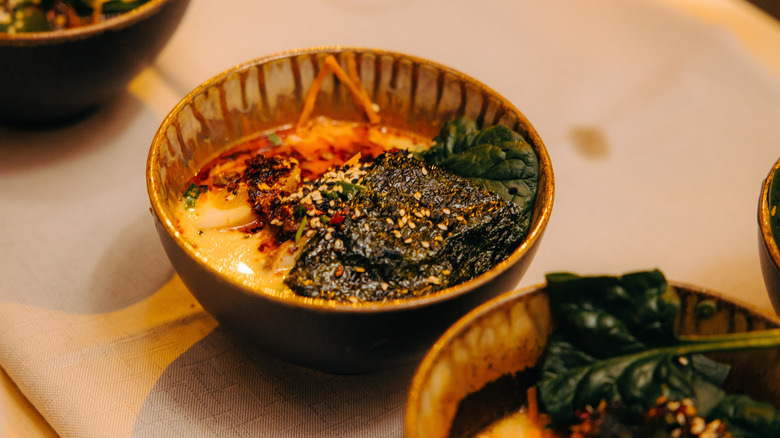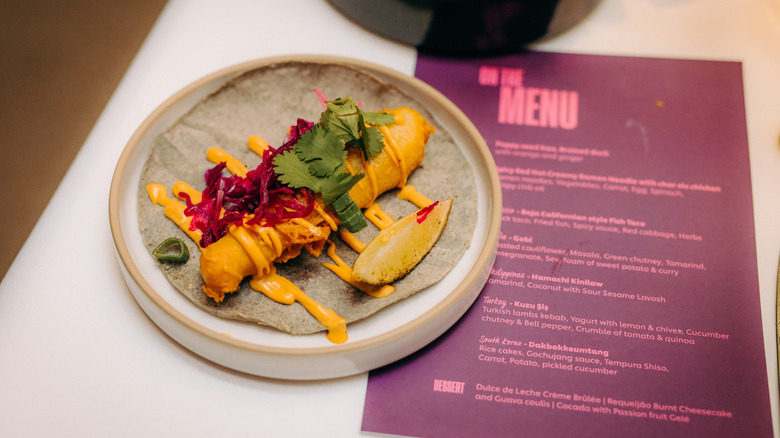The Biggest Food Trends Of 2025: Street Food Is Going Couture
Sponsored Content. The sponsor may receive a commission on purchases made from links.
From Seoul to Salvador, Los Angeles to Lagos, and all points in between, street food is the culinary heart and soul of cities worldwide. It's nourishment for the masses, offering affordability, diversity, and that all-important craveability. Need a morning pick-me-up? A crucial late night after party snack? Feeling sweet? Perhaps savory? Steamed, boiled, fried, or charcoal grilled? When it comes to street food, diners are bound to find delicious options aplenty that will satisfy any palate.
But in our social media driven world, flavor can only go so far – which is why it's no surprise that Street Food Couture is among four emerging global trends highlighted in the recently-announced Future Menus 2025, the annual trend report compiled by Unilever Food Solutions. This year's picks, which also include Borderless Cuisine, Culinary Roots, and Diner Design center around the theme of "food that moves us" and Street Food Couture certainly fits the bill.
Local specialties are gaining an international audience, whether its kebab shops finding ubiquity throughout Europe or Mexican elote fast becoming an American county fair staple. That global crossover, along with Gen Z's never ending quest for the next big thing, is helping to bring new life to familiar favorites.
It's not just for the 'gram
Before you sink your teeth into what Street Food Couture truly represents, it is important to get a sense of what it's not. Forget taking a tried and true street food staple like moo ping and simply wrapping the Thai pork skewer in gold leaf – in other words, putting lipstick on a pig for TikTok clout just won't do.
"You definitely don't want to just be like, 'here's your beef taco and I'm going to shove some caviar on it and you're going to give me $39 for it,' which I think sometimes is the perception," says Brandon Collins, Corporate Executive Chef for Unilever Food Solutions, North America. According to Collins, "Is there a reason why you're doing this?" should be the fundamental question that is at the heart of creating each dish, rather than simply whipping something up for the sake of appearing "super cool and trendy."
Of course, there are plenty of opportunities to explore the best of both worlds: bringing a personalized spin to a street food classic with creative flourishes that offer both style and substance.
Collins recognizes that several elements can be at play. A standard carne asada taco can be transformed by swapping flap meat for wood-fired grilled ribeye steak and splashing on a few dashes of house-fermented hot sauce for a touch of heat and dazzling complexity. "You're able to elevate not only the ingredients that are being put into the taco, but elevate the actual vision that is behind that taco as well," he says. "And I think that's when people are more comfortable spending a little bit more money on it."
Bringing the wow factor without breaking the bank
Street food is synonymous with dining on a budget, and with the continued cost of living crisis, quick and easy affordable options continue to flourish in cities around the world. Of course, bringing more labor-intensive techniques and costly ingredients to the fold means you're bound to pay more for the privilege. When it comes to Street Food Couture, these aren't necessarily cheap eats, but according to Chef Collins, "While we are elevating the humble street food, we still have to be that street food at its roots. Especially whenever we're talking about cost, you can't charge $97 for a taco."
Collins points to Chef Alex Stupak who's been wowing New York diners for over a decade with his breath-of-fresh air takes on Mexican street food at Empellón and his flagship's various sister restaurants. Fans continue to flock to his mini empire for crab nachos with sea urchin queso, pastrami tacos, and other exciting (and mouthwatering) fare you're not going to find at the truck around the corner.
Relative to a several hundred dollar tasting menu experience or a menu dominated by high-priced entrees, a selection of familiar yet inventive plates in the $10-30 range can seem like a relative bargain. According to Unilever Foods Solutions, 65% of Gen Z prioritizes value when dining out, and a meal centered on Street Food Couture would certainly satisfy that requirement while satiating their hunger for a meal worthy of a social media shout out.
Asian and Latin cuisines are taking center stage
The fabric for Street Food Couture can be woven from the cuisines of virtually any continent (apologies to Antarctica). But the influences of Asian street food, with its rich history and bold flavors, are shining particularly bright. Consider the iconic night markets of Southeast Asia – Bangkok's Chatuchak Market, Temple Street Night Market in Hong Kong, and Shilin Night Market in Taipei to name just a few. Across India, you'll find regional variations of chaats, samosas, and pani puri that are too numerous to count, not to mention Mumbai's storied Bombay Sandwich. Korean rice rolls and corn dogs. Japanese yakitori and takoyaki. The options are endless.
But perhaps no street food scene is having as big of a moment as Filipino cuisine. Often overshadowed by the familiar fare of its neighbors, the Philippines is impressing diners worldwide with its unforgettable combination of sweet, salty, and sour flavors highlighting a variety of dishes that shine on their own, but also offer opportunities for a touch of zhuzh. This is evident in Unilever Food Solutions Global Chef Dianne Araneta's Shrimp Bisque Crispy Noodles, a recipe featured in the Future Menus trend report. Her take on palabok, which is traditionally prepared with a shrimp-based sauce and pork crackling, infuses European and Japanese touches, bringing Dutch smoked mackerel and deep-fried shiitake mushrooms seasoned with togarashi to the mix.
On the other side of the world, street food is undergoing a stunning transformation across Latin America. "Street vendors, traditionally associated with emblematic dishes such as tacos, arepas, or empanadas have begun to reinvent their recipes, incorporating gourmet ingredients, modern cooking techniques, and cultural fusions that elevate the quality of their products, notes Andrés Cordona, Corporate Chef Unilever Food Solutions, North Latin America. "What was once simply a means of eating has become an artistic expression that celebrates the region's culinary diversity and creativity."
With the help of social media, this evolution is being broadcast to the masses. Street foods that were once only familiar to locals are now being celebrated and reinterpreted worldwide by chefs, influencers, and home cooks in an unprecedented wave of culinary innovation.
The height of street food couture
The beauty of Street Food Couture is the experience can be served up in myriad ways. Touchstones can be as simple as offering a constant rotation of menu options and creating an open kitchen for diners to learn (and record) the culinary magic as it unfolds. You can even consider incorporating pop-up events and collaborations with local artists for an added layer of excitement to the meal.
But there was perhaps no better distillation of what the trend has to offer than Unilever Food Solutions' Street Food Couture dinner to celebrate Future Menus 2025. For one night only, Amsterdam's Westergas Terrain was transformed into a stunning night market that bridged music, fashion, and, of course food for an unforgettable affair.
The nearly 200 revelers in attendance were treated to a globe-trotting menu that included a poppy seed-studded duck bao with a French flair, courtesy of the à l'orange-inspired filling, with a nod to Peking duck for the ultimate East-meets-West combo. A refreshing hamachi kinilaw brought a taste of the Philippines while the spicy red hot creamy ramen with char siu chicken featured an unexpected but welcome addition of Hellman's mayo. The event was a potent reminder of the unlimited potential of Street Food Couture and its ability to dazzle both taste buds and eyeballs.





